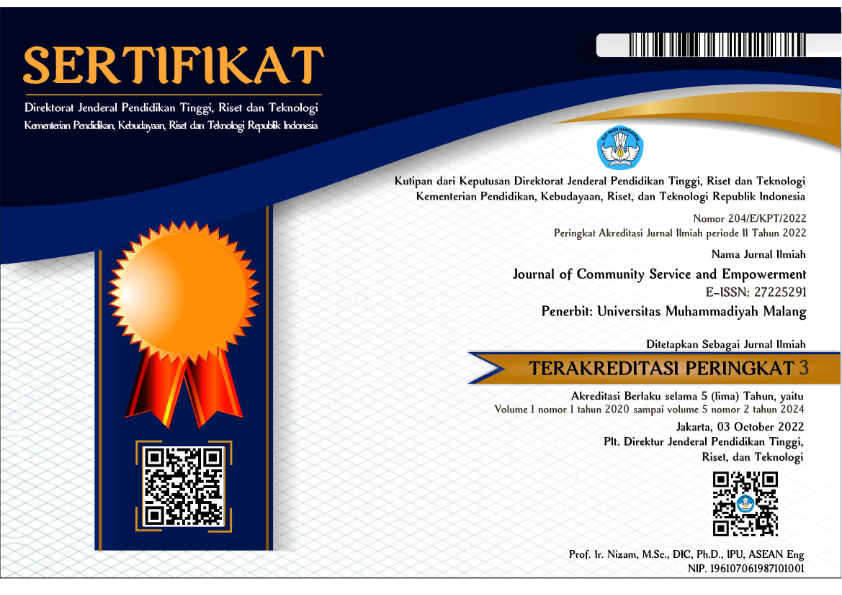Psychoeducational Implementation to reduce gadget addiction in children due to distance learning during the Covid-19 pandemic
DOI:
https://doi.org/10.22219/jcse.v4i1.24667Keywords:
gadget addiction, psychoeducation, Elementary school studentAbstract
The distance learning process using mobile phone (gadget) and internet is one of the strategies implemented to keep the learning process going even during the covid-19 pandemic. This method increases the use of gadgets and the internet in elementary school students which can caused a gadget addiction. Dependence on these gadgets causes obesity problems, sleep pattern disturbances, decreased brain and eye function, growth and development disorders and even mental problem. Psychoeducation is a strategy that can be applied to reduce gadget addiction. Psychoeducational activities are carried out by providing material for 45 minutes which is adjusted to the tendency of the five senses used in receiving student information with the Primary System instrument. Classes will be divided into two groups, visual and auditory. Evaluation of psychoeducational activities was carried out after three days of psychoeducational activities by measuring the level of student addiction to gadgets with the Smartphone Addiction Scale-Short Version instrument (SAS). Psychoeducational activities have been proven to reduce the level of gadget addiction at school, marked by a decrease in SAS-VS scores after psychoeducation with a p value of 0.001 (0<0.005). The results of the activity show the importance of educational activities to reduce children's gadget addiction. The next suggestion is that parents' participation is also needed to facilitate children to carry out other activities so that children are not dependent on the use of gadgets.
Downloads
References
Aljomaa, Suliman S., Mohammad F. Mohammad, Ismael S. Albursan, Salaheldin F. Bakhiet, and Adel S. Abduljabbar. 2016. “Smartphone Addiction among University Students in the Light of Some Variables.” Computers in Human Behavior 61:155–64. doi: 10.1016/j.chb.2016.03.041.
Anggraeni, Sri Wulan, Yayan Alpian, Depi Prihamdani, and Euis Winarsih. 2020. “Durasi Dan Frekuensi Penggunaan Gawai Terhadap Perkembangan Sosial Anak Pra Sekolah Di Tk Islam Permata Hati Kelapa Dua Kabupaten Tangerang Tahun 2019.” Jurnal Kebidanan Malahayati 6(4):427–34. doi: 10.33024/jkm.v6i4.2911.
Barotun Mabaroh, and Lilik Sugianti. 2021. “Gadget Addiction and the Students’ Achievement.” International Journal of Social Learning (IJSL) 1(3):321–32. doi: 10.47134/ijsl.v1i3.59.
Chairulhaq, Alfath Iqbaal, Alvina Mutia Hendarti, Reza Milenia Fendi, and Achmad Room Fitrianto. 2021. “Pendampingan Belajar Daring Untuk Mengurangi Kecanduan Gadget Pada Siswa Sekolah Dasar Optimizing Online Learning Assistance To Reduce Gadget.” EDUMASPUL: Jurnal Pendidikan 5(2):63–74.
Efastri, Sean Marta, Lucky Lhaura, and Chitra Charisma Islami. 2022. “Perbedaan Kemampuan Bersosialisasi Anak Yang Mengalami Kecanduan Gadget Dengan Yang Tidak.” Jurnal Obsesi : Jurnal Pendidikan Anak Usia Dini 6(5):4461–70. doi: 10.31004/obsesi.v6i5.2296. DOI: 10.31004/obsesi.v6i5.2296
Gunawan, Rudy, Suci Aulia, Handoko Supeno, Andik Wijanarko, Jean Pierre Uwiringiyimana, and Dimitri Mahayana. 2021. “Adiksi Media Sosial Dan Gadget Bagi Pengguna Internet Di Indonesia.” Techno-Socio Ekonomika 14(1):1. doi: 10.32897/techno.2021.14.1.544.
Hadi, M. Fahli Zatra. 2015. “Pemanfaatan Konseling Neuro Linguistic Programming.” Jurnal RISALAH 26(4):174–82. DOI: http://dx.doi.org/10.24014/jdr.v26i4.1275
Jalal, Novita Maulidya, Rahmawati Syam, St Hadjar, and Nurul Istiqamah. 2022. “Psikoedukasi Mengatasi Kecanduan Gadget Pada Anak.” 2(2):420–26. doi: 10.54259/pakmas.v2i2.1311.
Jayani, Dwi Hadya. 2021. “Penggunaan Internet Di Kalangan Siswa Sekolah Semakin Meningkat.” Databoks 1.
KumparanNEWS. 2020. “Survei KPAI: 79% Anak Pakai Gadget Selain Untuk Belajar Selama Pandemi Corona | Kumparan.Com.” KumparanNEWS.
Mun, So Youn, and Byoung Sook Lee. 2015. “Effects of an Integrated Internet Addiction Prevention Program on Elementary Students’ Self-Regulation and Internet Addiction.” Journal of Korean Academy of Nursing 45(2):251–61. doi: 10.4040/jkan.2015.45.2.251.
Nugroho, Febrian Andi, Siti Nurhidayah, and Setyo Supratno. 2022. “Psikoedukasi Pengendalian Emosi Pada Pengguna Game Online Di Desa Telaga Murni Kabupaten Bekasi.” Devosi 3(1):20–23. doi: 10.33558/devosi.v3i1.4411.
Petry, Nancy M., Florian Rehbein, Chih Hung Ko, and Charles P. O’Brien. 2015. “Internet Gaming Disorder in the DSM-5.” Current Psychiatry Reports 17(9). doi: 10.1007/s11920-015-0610-0.
Poli, Roberto. 2017. “Internet Addiction Update: Diagnostic Criteria, Assessment and Prevalence.” Neuropsychiatry 07(01):4–8. doi: 10.4172/neuropsychiatry.1000171.
Purwanto, A., Pramono, R., Asbari, M., Hyun, C., Wijayanti, L., Putri, R., & santoso, priyono. (2020). Studi Eksploratif Dampak Pandemi COVID-19 Terhadap Proses Pembelajaran Online di Sekolah Dasar. EduPsyCouns: Journal of Education, Psychology and Counseling, 2(1), 1-12. Retrieved from https://ummaspul.e-journal.id/Edupsycouns/article/view/397
Putri, Ratna Setyowati, Agus Purwanto, Rudy Pramono, Masduki Asbari, Laksmi Mayesti Wijayanti, and Choi Chi Hyun. 2020. “Impact of the COVID-19 Pandemic on Online Home Learning: An Explorative Study of Primary Schools in Indonesia.” International Journal of Advanced Science and Technology 29(5):4809–18.
Setianingsih, S. 2018. “Dampak Penggunaan Gadget Pada Anak Usia Prasekolah Dapat Meningkatan Resiko Gangguan Pemusatan Perhatian Dan Hiperaktivitas.” Gaster 16(2):191. doi: 10.30787/gaster.v16i2.297.
Setiati, Ayu Rosida, and Sunarsih Rahayu. 2017. “Faktor Yang Mempengaruhi Kejadian BBLR (Berat Badan Lahir Rendah) Di Ruang Perawatan Intensif Neonatus RSUD DR Moewardi Di Surakarta.” (Jkg) Jurnal Keperawatan Global 2(1):9–20. doi: 10.37341/jkg.v2i1.27.
Setiati, Siti, and Muhammad K. Azwar. 2020. “COVID-19 and Indonesia.” Acta Med Indones-Indones J Intern Med 52(1):84–89.
Setiawati, Yunias, and Izzatul Fithriyah. 2020. Deteksi Dini Dan Penanganan Kecanduan Gawai Pada Anak.
Tamura, Haruka, Tomoko Nishida, Akiyo Tsuji, and Hisataka Sakakibara. 2017. “Association between Excessive Use of Mobile Phone and Insomnia and Depression among Japanese Adolescents.” International Journal of Environmental Research and Public Health 14(7):1–10. doi: 10.3390/ijerph14070701.
Walther, Birte, Reiner Hanewinkel, and Matthis Morgenstern. 2014. “Effects of a Brief School-Based Media Literacy Intervention on Digital Media Use in Adolescents: Cluster Randomized Controlled Trial.” Cyberpsychology, Behavior, and Social Networking 17(9):616–23. doi: 10.1089/cyber.2014.0173.
Wulandari, Dwi, and Dilfera Hermiati. 2019. “Deteksi Dini Gangguan Mental Dan Emosional Pada Anak Yang Mengalami Kecanduan Gadget.” Jurnal Keperawatan Silampari 3(1):382–92. doi: 10.31539/jks.v3i1.843.
Yunita, Mutiara Mirah, Teguh Lesmana, Devi Jatmika, Alfina Damayanti, and Theresia Finda Kusuma. 2021. “Mengenal Bahaya Adiksi Gadget Dan Cara Mengatasinya.” Jurnal Pengabdian Dan Kewirausahaan 5(2):70–78. doi: 10.30813/jpk.v5i2.2980.

Downloads
Published
How to Cite
Issue
Section
License
Copyright (c) 2023 Asti Melani Astari, Sholihatul Amaliya, Annisa Wuri Kartika, Ayu Purnama, Nahdya Hamida, Nabila Novarani

This work is licensed under a Creative Commons Attribution-ShareAlike 4.0 International License.












